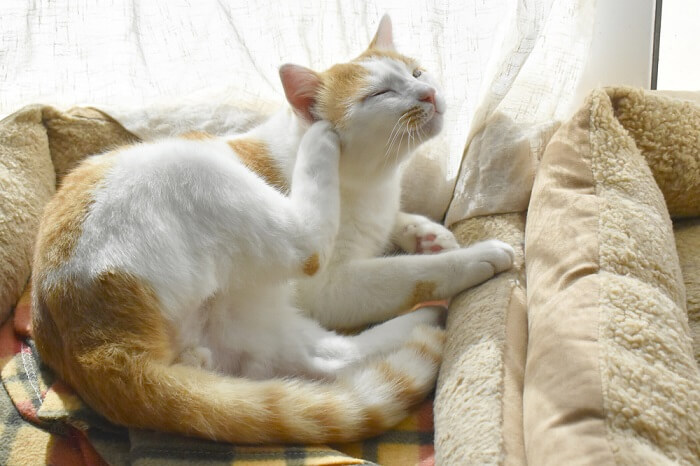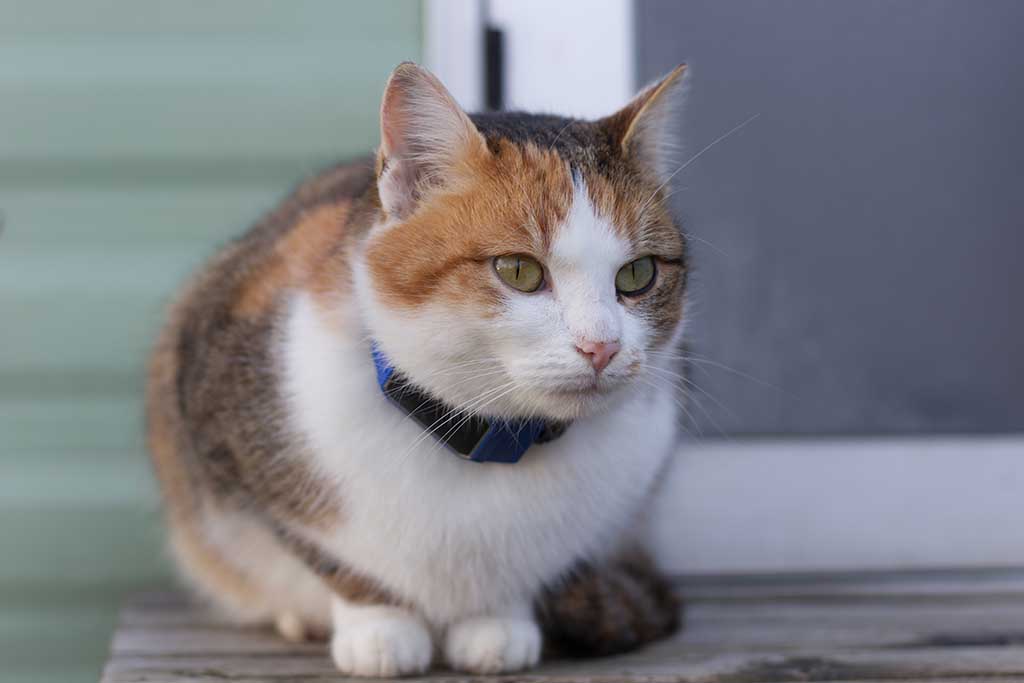
Flea bites are probably the most common cause of itchiness in cats, so cat owners should know how to identify fleas, and how to get rid of them from their cats. The aim of this article is to explain precisely how to do this.
Causes Of Flea Infestations In Cats

The life cycle of the cat flea is simple. After feeding on a pet, a female flea hops off, and lays eggs that go on to develop into flea larvae, which then change into pupae, and these go on to develop into young adult fleas. These young adults then hop onto a passing cat (or other mammal) and the cycle begins again.
Fleas like an environmental temperature of 21 – 29’C (70 – 84’F) for the life cycle to proceed. For this reason, in warmer, moister weather, the flea life cycle speeds up dramatically. This is why flea problems are more common in summer and in warmer countries.
In contrast, in cold weather, and cooler climates, fleas outside are inactive. Fleas will still be able to breed inside centrally heated homes, where it’s still be warm enough, but pet cats are less likely to come back carrying fleas after being outside.
What Do Fleas Look Like?

leas like an environmental temperature of 21 – 29’C (70 – 84’F). Fleas are around 3-4mm (1/4 to 1/3 inch)
Fleas are around 3-4mm (1/4 to 1/3 inch) long, black or dark brown, resembling flattened versions of ants. They usually move quickly through the coat, especially when exposed to the light (e.g. if you are searching through the cat’s coat to find them).
Sometimes cats get rabbit fleas and these are different: they tend to stay motionless, stuck around cats’ ears like black specks. However the same flea control methods apply.
Signs Of Fleas In Cats

Most flea-infested cats develop dermatitis, with hair loss and itchy skin especially over the lower back, around the head, and elsewhere.
A flea infestation can cause a range of signs in cats
Some cats are remarkably unreactive to fleas, and may show no signs of itchiness or skin disease at all, despite the fact that fleas may be seen running through their coat.
The most likely reason for this is that the response to fleas is based to some extent on an allergic reaction, and if a cat is not allergic to fleas, they may not cause a significant problem for that individual animal. However all of the cats in a house need to be treated for fleas, even if they show no reaction to fleas.
Most flea-infested cats develop dermatitis, with hair loss and itchy skin especially over the lower back, around the head, and elsewhere. Sometime a miliary dermatitis type reaction may be seen, with crusty, scabby areas.
Young kittens may become seriously ill after a heavy flea infestation, with systemic signs such as anemia caused by the kittens’ blood being ingested by the fleas.
Diagnosis Of Fleas In Cats

If you find flea dirt in your cat’s coat, this is regarded as definite proof of the presence of fleas.
If a cat has fleas, you may see the black creepy-crawlies scuttling through their coat. A fine-toothed flea comb can be used to run through your cat’s coat: this can be a good way of picking out adult fleas.
However you may not find adult fleas: you may just see so-called flea dirt. This resembles black specks of dirt in the coat: these are flea droppings, left behind by fleas after they’ve fed on cats’ blood. If you find black specks like this, pick some out of the coat and place them onto a piece of moist tissue paper or cotton wool.
If the specks are flea dirt, they will dissolve in the moisture, creating reddish brown smudges. This is because flea dirt is made up of small accumulations of digested blood.
If you find flea dirt in your cat’s coat, this is regarded as definite proof of the presence of fleas.
Sometimes, your pet’s groomer may make the diagnosis for you, informing you that your cat has fleas.
Treatment Of Fleas In Cats
There are many different types of flea treatment, each with different strengths and weaknesses.
Home Remedies

Many home remedies are recommended, from garlic to herbs to dish soap: in general, these treatments are relatively ineffective and it makes far more sense to use proven, modern, flea control methods and products.
Flea Shampoos

Flea shampoos are an old fashioned treatment which most cat owners find difficult to use on their pets. The details of their use depend on the active ingredients, but in general, they are only recommended in situations where a cat may need to be washed for other reasons as well as for fleas (e.g. certain types of dermatitis).
Flea Collars

Flea collars contain chemicals or herbs which either repel or kill fleas. A range of collars are available, and for specific details of what each collar does, and how long they last, the precise active ingredient needs to be known.
They may be strong insecticides like permethrin, or less effective but less toxic ingredients like essential oils.
Flea Sprays

Flea sprays can also contain different types of pesticides, with variable efficacy and duration. A typical ingredient is fipronil, which lasts for 5 weeks in cats. It can be difficult to spray a cat, so more recently developed ways of treating cats tend to be more popular.
Topical Spot-On Products

There are many different types of spot-on products, again varying in how long they last, and how effective they are. In general, the most effective and safest products tend to be prescription-only, sold though DVM veterinary clinics.
The general idea is that these flea products are drops that are squeezed from a small plastic vial onto the cat’s fur on the back of their neck, in a location that where it cannot be licked off. Typically, these products have efficacy for one month, but it’s important to read the label to be clear about their use.
Oral Tablets

Different types of chewable oral flea medication is available, such as spinosad, which is formulated into a beef flavored tablet. This medication starts to kill fleas within 30 minutes and kills 99% of fleas in cats within four hours, before they can lay eggs. The medication needs to be given once a month.
Also Read: The 11 Best Flea Treatments for Cats
How Safe And Effective Are The Different Methods Of Killing Fleas?

Once you understand the complex and long lifecycle of a flea, you can understand why it can be so hard to get a flea infestation under control.
All of these products are safe, as long as you follow the instructions on the label. Care is needed, of course: if a product for a large dog was applied to a cat, there’d be a risk of serious harm, or even a fatal reaction.
The need to use these products with care is one of the reasons why many of the best products are only sold through vets: professional supervision is important.
Is Flea Prevention Better Than Trying To Get Rid Of An Established Infestation?

Some pet owners use these flea control products just to treat their pets when they have an active infestation of fleas, but after a bad experience with fleas, many owners choose to use regular medication on their pets routinely, on a continual basis, as a preventative for fleas. Examples include once monthly spot-ons or tablets.
Treating The Environment

As well as treating the animal, it’s important to treat the place where your cats live. Adult female fleas jump off cats, crawling into carpets, crevices, furniture, upholstery, and cracks in floorboards.
These fleas go on to lay hundreds of eggs which can remain dormant for up to six months before hatching. If your pet has fleas, your home also has fleas, and you need to treat both the pet and the house.
Some people call in a professional exterminator or pest control firm, but there should not normally be a need for this.
First, carry out thorough vacuuming of your house with a powerful vacuum cleaner, putting the vacuum bag in the waste disposal as it may contain flea eggs.
Wash your pet’s bedding in hot water, with soapy water to ensure it is fully cleaned. Everything in the house that could have flea eggs needs to be cleaned.
Second, use an effective environmental spray that kills adult fleas as well as stopping any flea eggs from developing into adults, protecting the home for up to a year. An insect growth hormone regulator is an important ingredient to check for. This spray should be applied to every item in your home that could harbor flea eggs.
Third, be aware that if your cat goes outside in warm weather, there is a high chance that they will be exposed to a source of flea infection (e.g. an area of ground that is frequented by cats in the area). This may be the most common reason why flea infestations continue to recur.
The best answer to this is to use a once monthly anti-flea product on your cat, and to keep applying this all year round, so that your cat is continually protected.
Remember To Worm Your Cats After The Fleas Have Gone

Fleas carry the most common type of tapeworm, and if your cat has had fleas, they will need to be given an effective worm dose as a follow up, to keep them in optimal health.
Conclusion

To get rid of fleas from your cats and your home, you need to treat the animals, and you need to treat the house. There are different ways of doing this, and the most effective way is usually to consult with your local vet clinic, as they are likely to stock the most recently developed and most effective flea control products.
Frequently Asked Questions
What is the fastest way to get rid of fleas on a cat?
The best answer is to use prescription-only flea control products from your local veterinary clinic. There are different options, depending on the precise details of your cats and your home, but in general, this involves treating your cat, and also treating your house.
What is the best flea remedy for cats?
There is no single best flea remedy, as each product has strengths and weaknesses. The best answer is to talk in detail with your veterinarian, explaining the details of your problem. They will recommend the best answer for your individual situation.
What kills fleas instantly on kittens?
A simple fipronil spray, used according the the label, may be the best answer, but it's safest to consult with your local veterinarian to be sure.
How did my indoor cat get fleas?
Flea eggs can live in the house for up to a year before hatching out, so if there are any visiting animals (dogs or cats) to your home, it is possible that they could leave fleas behind which could lay eggs, causing an infestation in your can many months later.








Hi, Thank you, sir, Your post help me cats but, my kitty is young I do not know what to use on her. please help
Nice and amazing post. I also have pet cats in my home from long time. This article really gives me a lot of information. Thank You!